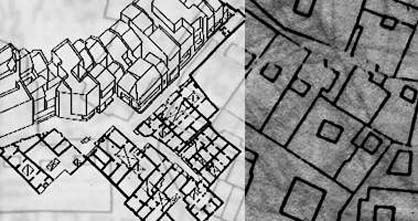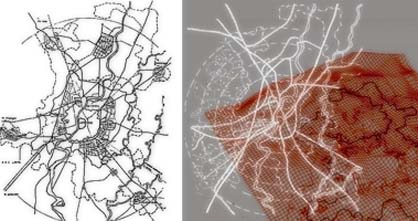|
|
||||
| home | ||||
| a City-Machine Anand Bhatt |
||||
a City-Machine, computations of the actions of fluids upon fluids—the Jamuna river bed in the heart of New Delhi, small bunds canalise and control the velocity of the river flow, siphons are created which are then used as a engraving edge to chisel the soil itself. The engraved earth is carried as particles suspended within the engraving fluid, only to reach repository areas, where the waters pause and deposit their contents, giving the city a new set of plateux in the heart of the river. The diurnal flux of the river flow, and monsoon floods 'level' this formation, which is generated time and again. And a new formation grows over years. There are no finalities and fixities here, the new urban structure emerges in a process of inscribing and erasing, it appears and lapses over time. It is all a matter of viscosity, of velocity, of oozing and depositing.  project: M. Rastogi, TVB School of Habitat Studies. for the Heterology Design Studio Cycle, Anand Bhatt, unit master.-1998. |
[30apr2001] | |||
| earth A fluid, a globe in space constituted by mutual attractions-repulsion of molecules in the expanse of space. A product of forces—of electricity-magnatism, of gravity, of fire, of coming together of particles, of mass and gravity. Always mobile. Life exists within this mobility, animals inhabit the earth's flows, on the crusts that form upon the earth's molten core. In the oceans, the air and what we presume to be terra firma. |
||||
animals Animals make cities, we know this—animals inhabit this earth, animals must protect their bodies from this earth. Animals must gather in their multitude, in-mass, they must form in a corpus in order to survive this earth. They must specialise, they must delegate, they must evolve and originate practices in order to survive. They must synchronise as a body, within the body of this earth. But before that, they must enclose. Animal practices articulate the body of this earth. By their enclosure they bring about constructs within the body. Constructs specific to a species, to a genera, to a group. They constitute networks, they form habits and behaviours. They have systems and rules, they even have abilities to transgress rules, apes are not cannibals, for example, except under special circumstances. |
||||
a
machine Homo Sapiens make buildings—this is a part of their process of synchronisation, their territiorizliation within the body of this earth. And in this manner they are like all other animals, yet there is something unique about the Homo Sapiens' processes. They abstract. They create values quite alien to the body of this earth. They alienate substances from the body, they create processes of production that are grafted onto the body, they create flows—or movements that the body does not register in the same way. Homo Sapiens have this unique ability to stack abstractions. To represent, and then to operate upon the representation. It is not enough for them to live, they must speak about it. They must separate from themselves, they must expand their territories—they must become complex. That which is given is not enough for us.  We must enclose, not from the body of the earth, but within our abstractions. We must enclose not inside but from the body of this earth. And we must speak about this enclosure. We have always created virtual worlds; or architecture, in other words. Architectures that speak about our existence, or of 'origin' and Techne. We must dwell within the mobilities, architectures we must have, architectures we must abstract form this practice of making cities—of forming bodies within the body of this earth. Architecture is the process by which we insist on our separation from our animalities. Something is stolen from our animalities; something is purified and held in front of as a mirror or an illusion. A mirage. An ex-centricity that must mobilise us. Architecture, which is something I confess to, is in other words an act of divination. I divine space. And therefore I construct a practice, the practice of architecture which is a divining-machine. It is a process inhabiting the city: it 'divines’ the city as it works inside it. And cities as repositories of this virtuality. A practice that maps our ex-centricities. It is an instrument by which one knows, perhaps represents this knowing. |
||||
a City-Machine A City-Machine puts to test this simple statement: Architecture Maps the City, and architecture mimics the city: it is in turn mapped by the city. It is the instrument par excellence wielded necessarily by the central powers as they come to form the city. A machine constructed of flows, and an architecture shaped by the energies latent in the flow: by itself. The place already has the energy and the material for architecture—gravity, viscosity, gradient, deposition and forces of nature. The urban question concerns, then, the mashing of the Homo Sapiens into this machine, the body of earth itself. Homo Sapiens with his urban motives, separated from the body of the earth: standing upright as a number of modern mythologies would have it. In any case, separated from the body of earth and wrapped in a shell of articulated space, made symbolic and meaningful. Shell of language and the possibility of languaging. Into the shell brought about by the institution of the laws of possession, simple or otherwise, of exchange so on. Homo Sapiens, animal, trapped in his own economies. a City Machine exists in the City like Water in water. It creates series of articulations that come about as organs form within the media, the City as we know it, as its forces constitute a Flexion, a City-Machine is no more than a diagramme of these forces: contained within and shaped by—at once shaping its armatures, the city as is seen and experienced. The resulting condition: we see a ruptured body of the city, if the city was considered a corporate entity, this is a new organism sprouting organs extracted from multiple origins. Organs existent in a state of constant provocation. It is by provocation that they propel themselves and change. Urban systems are generated of this antagonism. One sees the beginning of a vast locational logic, a dispersed systems of pseudo places. The bricks of a new city. The city will then be understood as a vast process of decoding-encoding. Values embedded into its structure [the proximities, exposures: the whole logic of location in relation to the system of flows in-themselves] are decoded, and buildings actuated—representing this decoding. Buildings formalise the de-coded. They come into existence as they represent values decoded and thus exploited: brought into light. Into the domain of exchanges. The decoding-encoding brings tangible shapes to the form of the city: its’ structures, signification and other identifiable attributes. The city, in other words, becomes a product of uprooting. Of fluid masses of the uprooted, ’I’ is placed within the tensions, the provocations. ‘I’ must constantly adapt, camouflage oneself [mimesis]: one takes a stand, or takes flight. People mirror, buildings mirror. Ephemeral ‘conventions’ come into existence. Bereft of motives beyond itself the city represents only itself. To itself. Like an animal it constantly endeavours to reproduce itself. And devouring itself in order to reproduce. It contains, is contained and even consumes it’s own excrement. At times, we witness the twilight of the city. It copulates with itself. It computes and becomes a City-Machine. It is an ethereal city. We inhabit it, wraithlike. We, the dream walkers. Anand Bhatt interface.public@ab-a.net |
||||
| laboratorio
|
||||